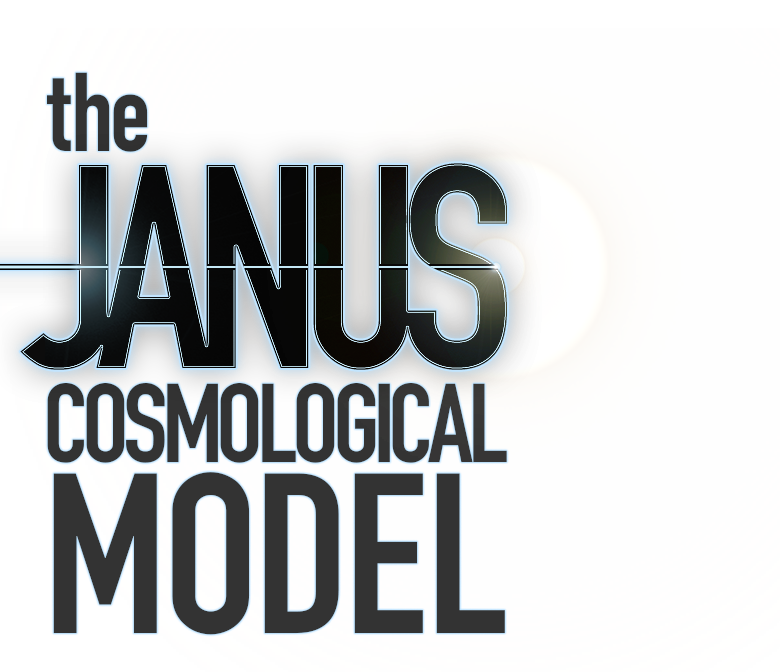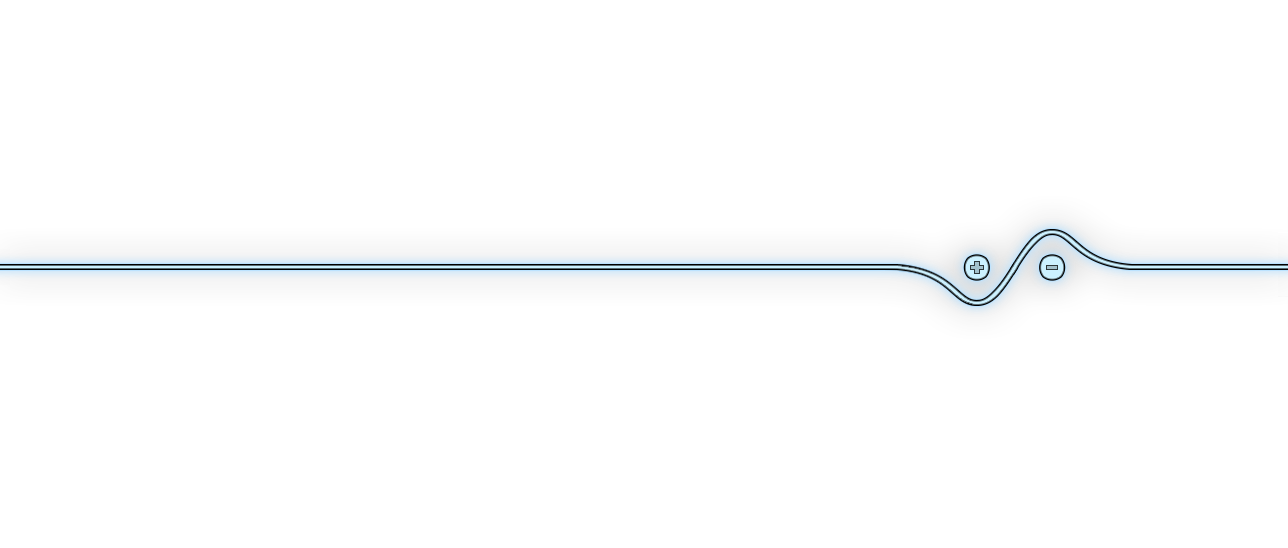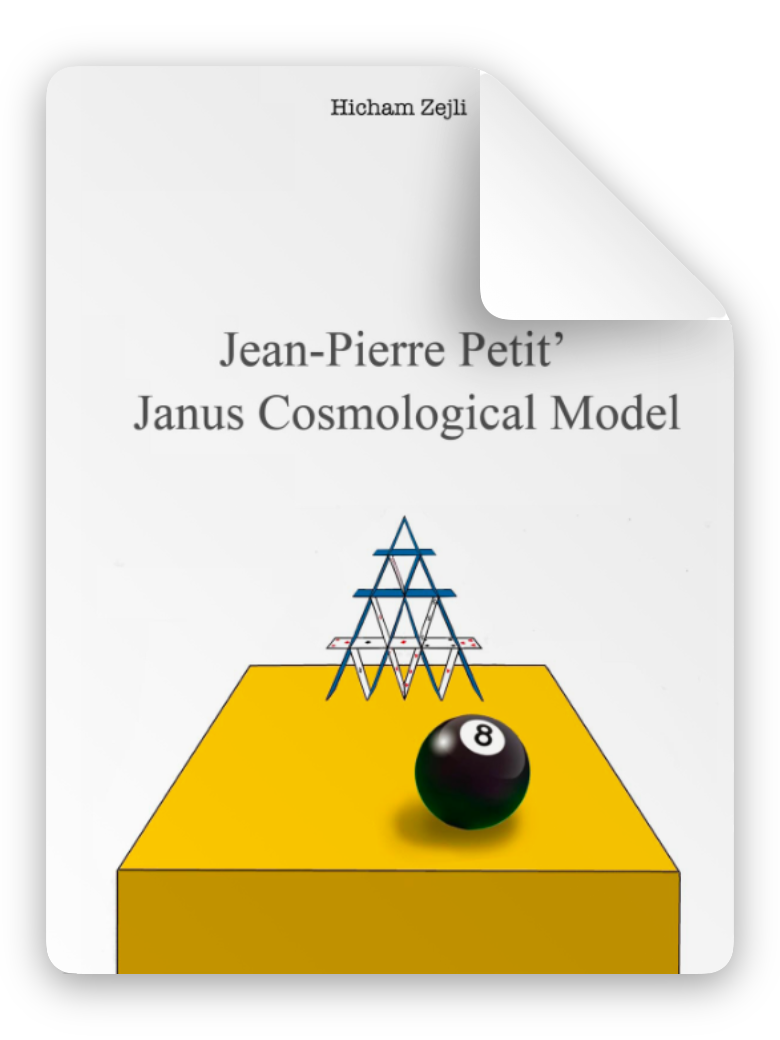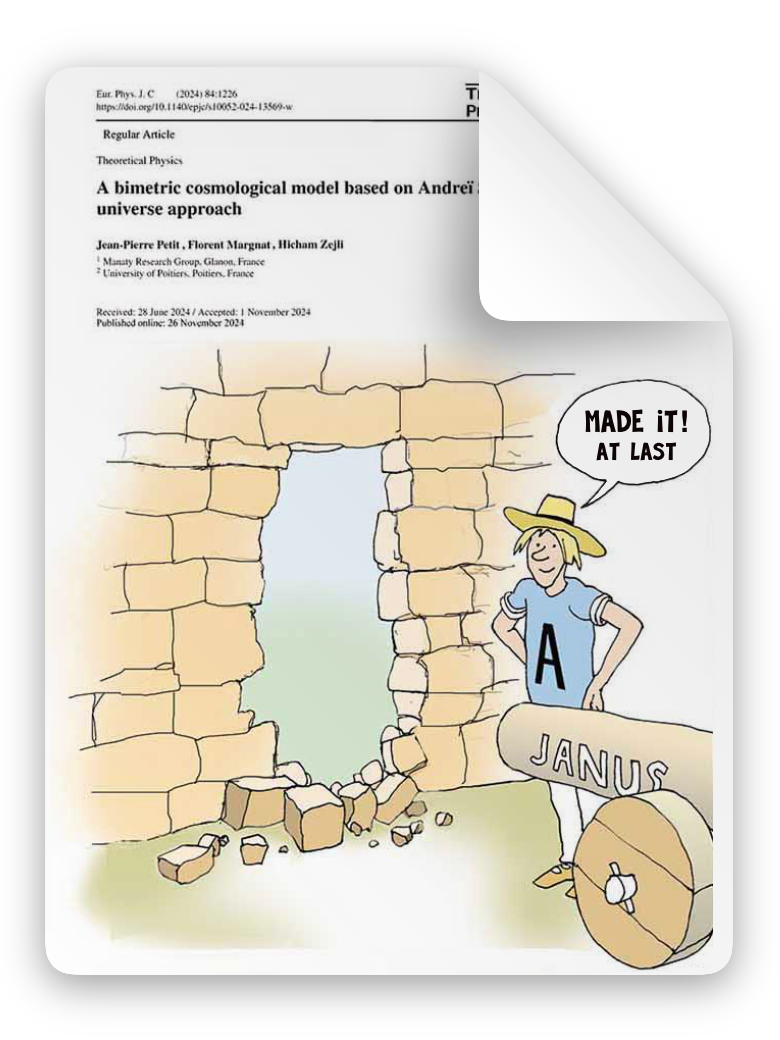

LATEST NEWS (2025)

The Janus Cosmological Model can be downloaded for free! This is an excellent and complete book (233 pages) explaining the model in great detail.
Also available in French/Le livre en français est aussi gratuitement téléchargeable ici.

Left: a good picture is worth a thousand words. The essentials of the Janus model (i.e. its mathematical foundations, developments and observational confirmations) were published late 2024 in EPJ C, a top-tier scientific journal. Click on the picture, the paper is in open access to make it accessible to as many people as possible. Also available on arXiv.
A paradigm shift
The Janus Cosmological Model (JCM) describes the universe as a Riemannian manifold with two different metrics that handle positive and negative masses in general relativity with no paradox, in very good agreement with latest observational data. The theory is published in peer-reviewed academic journals.
The Janus Cosmological Model merges Albert Einstein's theory of general relativity, Andrei Sakharov's work in particle physics and cosmology, and Jean-Marie Souriau's work in symplectic geometry.
The theory originated in 1977 from French physicist Jean-Pierre Petit, first as a non-relativistic model (Newtonian dynamics) of two enantiomorphic universes with opposite arrows of time: the twin universe theory. 1 2
The author was also the first, in 1988, to introduce a variable speed of light (VSL) in cosmology, as a joint variation of all physical constants following a universal gauge relationship, letting the laws of physics invariant. This solution challenges the inflation hypothesis. 3 4 5
As of 1994, both theories were then merged into a VSL relativistic bimetric model of gravity. 6 7 8 9
From the 2000s, the addition of dynamical group theory explains why time reversal goes with energy and mass inversion, a fundamental property of particles secreted by the complete Poincaré group. 10 11 12 31
In the 2010s, the modern theoretical developments lead to the Janus cosmological model, named after the two-faced Romanian god who “looks simultaneously to the future and to the past.” 13 14 15 17 18 20 22 30
Dr. Petit also questions the classical black hole model and the true nature of such stellar objects, theoretically exploring the so-called event horizon in both its spatial (what is behind it?) and temporal (the "freeze-frame" effect) implications. An aspect of the Janus model that, when coupled to the VSL developments cited above and the bimetric nature of the Universe, could led to technological applications tightly related to the possibility of (apparent) FTL interstellar travel. 16 19 25 29
The model also shows how negative energy states are compatible with quantum mechanics. 21 24 26 27 28
The Janus system of two coupled field equations has been independently derived from the differential form of the Einstein field equations using Cartan's equivalence method and the Hodge star operator. 23
Discover in the next pages how the Janus cosmological model challenges the mainstream ΛCDM model without resorting to dark matter nor dark energy of unknown nature, and why it is the only theory able to reconcile negative mass with general relativity:
References
All scientific papers cited in this page are listed below. You can open PDF files clicking on their title. Purple labels are original papers cited for historical purpose. If you know some maths (student, scientist, engineer…) and you are discovering the Janus cosmological model, we suggest to begin with red labels which are most recent core papers. As for Green labels, they are books, either technical or popularization courses (science comics) from the author that are perfect to begin with. Published papers are listed classically in chronological order, while books are in retrochronological order (most recent books at the top of the list).
Published papers
in chronological order
1 Petit, J.-P. (23 May 1977):
"Univers jumeaux, énantiomorphes, à temps propres opposés"
[Enantiomorphic twin universes with opposite proper times]
Comptes rendus de l'Académie des Sciences (in French). Paris: French Academy of Sciences. 263: 1315–1318.
2 Petit, J.-P. (6 June 1977):
"Univers en interaction avec leurs images dans le miroir du temps"
[Universes interacting with their opposite time-arrow fold]
Comptes rendus de l'Académie des Sciences (in French). Paris: French Academy of Sciences. 284: 1413–1416.
3 Petit, J.-P. (16 November 1988):
"An interpretation of cosmological model with variable light velocity"
Modern Physics Letters A. 3 (16): 1527–1532. doi:10.1142/S0217732388001823.
4 Petit, J.-P. (18 December 1988):
"Cosmological model with variable light velocity: the interpretation of red shifts"
Modern Physics Letters A. 3 (18): 1733–1744. doi:10.1142/S0217732388002099.
5 Petit, J.-P.; Viton, M. (10 November 1989):
"Gauge cosmological model with variable light velocity: Comparizon with QSO observational data"
Modern Physics Letters A. 4 (23): 2201–2210. doi:10.1142/S0217732389002471.
6 Petit, J.-P. (July 1994):
"The missing-mass problem"
Il Nuovo Cimento B. 109 (7): 697–709. doi:10.1007/BF02722527.
7 Petit, J.-P. (April 1995):
"Twin universes cosmology"
Astrophysics and Space Science. 227 (2): 273–307. doi:10.1007/BF00627375.
8 Petit, J.-P.; d'Agostini, G. (August 2007):
"Bigravity: a bimetric model of the Universe with variable constants, including VSL (variable speed of light)"
International Meeting on Variational Techniques. Le Mont-Dore (France). arXiv:0803.1362.
9 Petit, J.-P.; d'Agostini, G. (September 2008):
"A bimetric model of the Universe. Interpretation of the cosmic acceleration. In early time a symmetry breaking goes with a variable speed of light era, explaining the homogeneity of the early Universe. The c(R) law is derived from a generalized gauge process evolution"
11th international conference on Physical Interpretations of Relativity Theory (PIRT XI), Imperial College, London.
10 Petit, J.-P.; Midy, P.; Landsheat, F. (June 2001):
"Twin matter against dark matter"
Marseille Cosmology Conference Where's the Matter? Tracing Dark and Bright Matter with the New Generation of Large Scale Surveys, Marseille, France.
11 Henry-Couannier, F.; d'Agostini, G.; Petit, J.-P. (February 2005):
"I- Matter, antimatter and geometry. II- The twin universe model: a solution to the problem of negative energy particles. III- The twin universe model plus electric charges and matter-antimatter symmetry". arXiv:0712.0067.
12 Petit, J.-P.; d'Agostini, G. (August 2007):
"Bigravity as an interpretation of the cosmic acceleration"
International Meeting on Variational Techniques. Le Mont-Dore, France. arXiv:0712.0067.
13 Petit, J.-P.; d'Agostini, G. (December 2014):
"Negative mass hypothesis in cosmology and the nature of dark energy".
Astrophysics and Space Science. 354 (2): 611–615. doi:10.1007/s10509-014-2106-5.
14 Petit, J.-P.; d'Agostini, G. (November 2014):
"Cosmological bimetric model with interacting positive and negative masses and two different speeds of light, in agreement with the observed acceleration of the Universe"
Modern Physics Letters A. 29 (34): 1450182. doi:10.1142/S021773231450182X.
15 Petit, J.-P.; d'Agostini, G. (May 2015):
"Lagrangian derivation of the two coupled field equations in the Janus cosmological model"
Astrophysics and Space Science. 357 (67). doi:10.1007/s10509-015-2250-6..
16 Petit, J.-P.; d'Agostini, G. (March 2015):
"Cancellation of the central singularity of the Schwarzschild solution with natural mass inversion process"
Modern Physics Letters A. 30 (9): 1550051. doi:10.1142/S0217732315500510.
17 Petit, J.-P. (January 2018):
"A Symplectic Cosmological Model"
Progress in Physics. 14 (1): 38–40.
18 D'Agostini, G.; Petit, J.-P. (June 2018):
"Constraints on Janus Cosmological model from recent observations of supernovae type Ia"
Astrophysics and Space Science. 363 (7): 139. doi:10.1007/s10509-018-3365-3.
19 Petit, J.-P.; Debergh, N.; D'Agostini, G. (September 2018):
"Negative energy states and interstellar travel"
Advanced Propulsion Workshop. Estes Park, CO: Space Studies Institute.
20 Petit, J.-P. (October 2018):
"Janus Cosmological Model and the Fluctuations of the CMB"
Progress in Physics. 14 (4): 226–229.
21 Debergh, N.; Petit, J.-P.; D'Agostini, G. (November 2018):
"On evidence for negative energies and masses in the Dirac equation through a unitary time-reversal operator"
Journal of Physics Communications. 2 (11): 115012. doi:10.1088/2399-6528/aaedcc. arXiv:1809.05046.
22 Petit, J.-P.; D'Agostini, G.; Debergh, N. (January 2019):
"Physical and Mathematical Consistency of the Janus Cosmological Model (JCM)"
Progress in Physics. 15 (1): 38–47.
23 Marquet, P. (July 2019):
"Twin Universes: a New Approach"
Progress in Physics. 15 (2): 64–67.
24 Guay, B. (January 2020):
"Dirac Field of Negative Energy and Primordial Antimatter Incursion"
International Journal of Modern Theoretical Physics. 9 (1).
25 Koiran, P. (November 2021):
"Infall time in the Eddington–Finkelstein metric, with application to Einstein–Rosen bridges"
International Journal of Modern Physics D. 30 (15). arXiv:2110.05938. doi:10.1142/S0218271821501066.
26 Debergh, N.; Petit, J.-P. (January 2022):
"On some reasons why the time reversal operator could be unitary"
Physics Letters A. 422: 127791. doi:10.1016/j.physleta.2021.127791.
27 Guay, B. (February 2022):
"Experimental test to verify whether quantum states of conjugated mass and energy exist"
Modern Physics Letters A. 37 (3). doi:10.1142/S0217732322500134.
28 Debergh, N.; Petit, J.-P. (April 2023):
"On spacetime algebra and its relations with negative masses"
Reports on Mathematical Physics. 91 (2): 165–181. arXiv:2211.07359. doi:10.1016/S0034-4877(23)00023-X.
29 Koiran, P.; Zejli, H.; Levy, J.-P.; Margnat, F.; Duval, M.-F.; Zejli, H. (November 2024):
"PT-symmetry in one-way wormholes"
Annals of Physics. 470 (470): 169765. arXiv:2409.02951. doi:10.1016/j.aop.2024.169765.
30 Petit, J.-P.; Margnat, F.; Zejli, H. (November 2024):
"A bimetric cosmological model based on Andrei Sakharov's twin universe approach"
European Physical Journal C. 84: 1226. arXiv:2412.04644. doi:10.1140/epjc/s10052-024-13569-w.
31 Petit, J.-P.; Zejli, H. (December 2024):
"Study of symmetries through the action on torsors of the Janus symplectic group"
Reviews in Mathematical Physics. 2450054. doi:10.1142/S0129055X24500545.
Technical books & popularized science comic books
in retrochronological order
A Zejli, H. (2024):
"Jean-Pierre Petit's Janus Cosmological Model"
(complete technical book about the Janus model)
B Petit, J.-P. (2008):
"The Twin Universe"
The Adventures of Archibald Higgins. Savoir Sans Frontières.
(comic book about the Janus model)
C Petit, J.-P. (2008):
"Faster Than Light"
The Adventures of Archibald Higgins. Savoir Sans Frontières.
(comic book about the variable speed of light aka 'VSL' theory)
D Petit, J.-P. (1980):
"Here's Looking at Euclid"
The Adventures of Archibald Higgins. Savoir Sans Frontières.
(introduction to flat and curved spaces, including geodesics)
E Petit, J.-P. (1985):
"Black Hole"
The Adventures of Archibald Higgins. Savoir Sans Frontières.
Also edited in print: Los Altos: W. Kaufmann. ISBN 086576069-1.
(introduction to extremely curved spaces)
F Petit, J.-P. (1985):
"Topo The World"
The Adventures of Archibald Higgins. Savoir Sans Frontières.
Also edited in print: Los Altos: W. Kaufmann. ISBN 086576092-6.
(comic book about topology, in particular Boy's surface)
G Petit, J.-P. (1986):
"Big Bang"
The Adventures of Archibald Higgins. Savoir Sans Frontières.
Also edited in print: Los Altos: W. Kaufmann. ISBN 086576070-5
(comic book about cosmology and the early universe)
H Petit, J.-P. (1986):
"A Thousand Billion Suns"
The Adventures of Archibald Higgins. Savoir Sans Frontières.
(comic book about astrophysics)
I Petit, J.-P. (1990):
"The Chronologicon"
The Adventures of Archibald Higgins. Savoir Sans Frontières.
(comic book about time and entropy in cosmology)